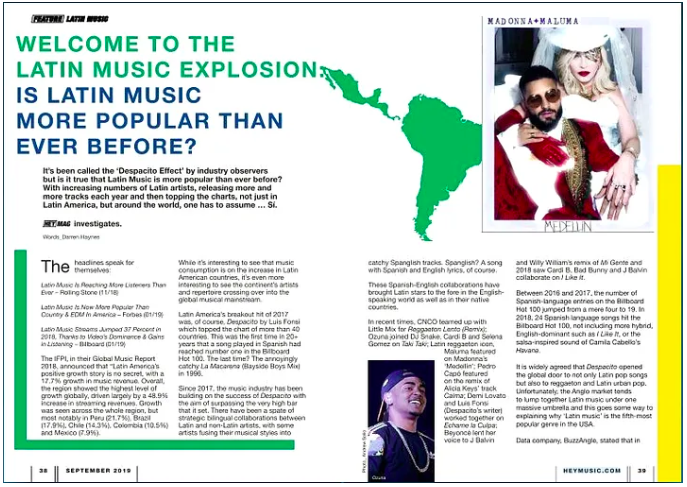

IS LATIN MUSIC MORE POPULAR THAN EVER BEFORE?
It’s been called the ‘Despacito Effect’ by industry observers but is it true that Latin Music is more popular than ever before? With increasing numbers of Latin artists, releasing more and more tracks each year and then topping the charts, not just in Latin America, but around the world, one has to assume … Sí. Hey Mag investigates. Words_Darren Haynes. [First published in Hey Mag, September 2019]
The headlines speak for themselves:
Latin Music Is Reaching More Listeners Than Ever — Rolling Stone (11/18)
Latin Music Is Now More Popular Than Country & EDM In America — Forbes (01/19)
Latin Music Streams Jumped 37 Percent in 2018, Thanks to Video’s Dominance & Gains in Listening — Billboard (01/19)
The IFPI, in their Global Music Report 2018, announced that “Latin America’s positive growth story is no secret, with a 17.7% growth in music revenue. Overall, the region showed the highest level of growth globally, driven largely by a 48.9% increase in streaming revenues. Growth was seen across the whole region, but most notably in Peru (21.7%), Brazil (17.9%), Chile (14.3%), Colombia (10.5%) and Mexico (7.9%).
While it’s interesting to see that music consumption is on the increase in Latin American countries, it’s even more interesting to see the continent’s artists and repertoire crossing over into the global musical mainstream.
Latin America’s breakout hit of 2017 was, of course, Despacito by Luis Fonsi which topped the chart of more than 40 countries. This was the first time in 20+ years that a song played in Spanish had reached number one in the Billboard Hot 100. The last time? The annoyingly catchy La Macarena (Bayside Boys Mix) in 1996.
Since 2017, the music industry has been building on the success of Despacito with the aim of surpassing the very high bar that it set. There have been a spate of strategic bilingual collaborations between Latin and non-Latin artists, with some artists fusing their musical styles into catchy Spanglish tracks. Spanglish? A song with Spanish and English lyrics, of course.
These Spanish-English collaborations have brought Latin stars to the fore in the English-speaking world as well as in their native countries.
In recent times, CNCO teamed up with Little Mix for Reggaeton Lento (Remix); Ozuna joined DJ Snake, Cardi B and Selena Gomez on Taki Taki; Latin reggaeton icon, Maluma featured on Madonna’s ‘Medellín’; Pedro Capó featured on the remix of Alicia Keys’ track Calma; Demi Lovato and Luis Fonsi (Despacito’s writer) worked together on Echame la Culpa; Beyoncé lent her voice to J Balvin and Willy William’s remix of Mi Gente and 2018 saw Cardi B, Bad Bunny and J Balvin collaborate on I Like It.
Between 2016 and 2017, the number of Spanish-language entries on the Billboard Hot 100 jumped from a mere four to 19. In 2018, 24 Spanish language songs hit the Billboard Hot 100, not including more hybrid, English dominant such as I Like It, or the salsa-inspired sound of Camila Cabello’s Havana.
It is widely agreed that Despacito opened the global door to not only Latin pop songs but also to reggaeton and Latin urban pop. Unfortunately, the Anglo market tends to lump together Latin music under one massive umbrella and this goes some way to explaining why ‘Latin music’ is the fifth-most popular genre in the USA.
Data company, BuzzAngle, stated that in terms of album consumption, Latin took a 9.4% share of the US market in 2018. Hip-hop led the way (with 21.7% of all album consumption) and was followed by pop, rock and R&B. The report confirmed that Latin music now ranks ahead of country music, which has a 8.7% share of the market.
When it comes to talking about the Latin music market stats, one word keeps popping up: ‘streaming’. Technology is enabling geographic and cultural crossover. It is now easier for new grassroots artists to be featured in genre playlists and build an audience. For example, flagship playlists such as Spotify’s Baila Reggaeton and Viva Latino! can almost single-handedly create hits around the world.
For example, Venezuelan artist, Danny Ocean, broke the record for the longest running entry in the Spotify Global Top 50 with his song Me Rehúso. J Balvin, Ozuna and Bad Bunny were amongst Spotify’s most listened to artists in 2018.
Eight of YouTube’s top 10 most viewed videos worldwide in 2018 were songs played in Spanish — interestingly enough — with Puerto Rican singer, Ozuna, appearing in four of them.
According to Nielsen Music’s 2018 year-end numbers for the US, Latin (defined as “music whose lyrics are more than half in Spanish”) saw a 57.1 percent upturn in total audio streams, from 16.1 billion in 2017 to 25.3 billion in 2018. As for video, there were 44.5 billion streams in 2018, accounting for 18.4 percent of the total video streaming market.
Latin Music is gaining in popularity. Fact. We are seemingly in Latin music’s big moment in terms of dynamism in the market and fan engagement with the music. Latin music’s growth is only making better business for everyone: for the industry, for the artists and for the music lovers around the world. Vamos!
